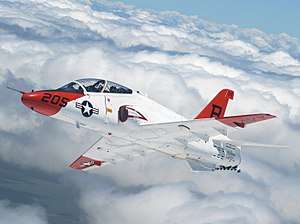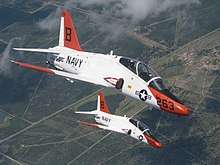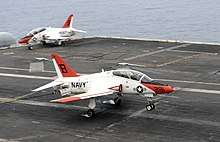McDonnell Douglas T-45 Goshawk
| T-45 Goshawk | |
|---|---|
 | |
| The T-45A in flight | |
| Role | Naval trainer aircraft |
| Manufacturer | McDonnell Douglas Boeing BAE Systems |
| First flight | 16 April 1988[1] |
| Introduction | 1991 |
| Status | In service |
| Primary user | United States Navy |
| Number built | 221[2] |
| Developed from | BAE Systems Hawk |
The McDonnell Douglas (now Boeing) T-45 Goshawk is a highly modified version of the British BAE Systems Hawk land-based training jet aircraft. Manufactured by McDonnell Douglas (now Boeing) and British Aerospace (now BAE Systems), the T-45 is used by the United States Navy as an aircraft carrier-capable trainer.
Development
Background
The T-45 Goshawk has its origins within the mid-1970s, during which time the U.S. Navy formally commenced its search for a new jet trainer aircraft to serve as a single replacement for both its T-2 and TA-4 trainers.[3] During 1978, the VTXTS advanced trainer program to meet this need was formally launched by the U.S. Navy. An Anglo-American team, comprising British aviation manufacturer British Aerospace (BAe) and American aircraft company McDonnell Douglas (MDC), decided to submit their proposal for a navalised version of the land-based BAE Systems Hawk trainer. Other manufacturers also submitted bids, such as a rival team of French aircraft company Dassault Aviation, German manufacturer Dornier and American aerospace company Lockheed, who offered their Alpha Jet to fulfil the requirement.[3]
The VTX-TS competition was not simply for the procurement of an aircraft in isolation; it comprised five core areas: the aircraft itself, capable flight simulators, matured academic training aids, integrated logistic support, and program management.[3] For their proposal, MDC was the prime contractor and systems integrator, BAe functioned as the principal subcontractor and partner for the aircraft element, Rolls-Royce provided the Adour engine to power the aircraft, and Sperry is the principal subcontractor for the simulator system.[3] During November 1981, the U.S. Navy announced that it had selected the Hawk as the winner of the VTX-TS competition.[3] Reportedly, approximately 60 per cent of the work on the T-45 program was undertaken overseas in Britain. During September 1982, a Full Scale Engineering Development contract was awarded to the team to fully develop and produce the proposed aircraft, which had been designated as the T-45 Goshawk.[3] On 16 April 1988, the first T-45A Goshawk conducted its maiden flight.[4]
Production

Work on the production of the Goshawk was divided between the two primary partner companies. BAE Systems (BAe's successor following its merger with Marconi Electronic Systems during 1999) was responsible for manufacturing the fuselage aft of the cockpit, along with the air inlets, and the vertical stabilizer of the T-45 at their Samlesbury facility, while the wings were produced at the company's plant at Brough, England. Boeing (which had merged with McDonnell Douglas during 1997) performed the manufacture of the remaining elements of the Goshawk, as well as conducting assembly of the type at a production line at St. Louis, Missouri, after having transferred work on the program from the company's facility in Long Beach, California.
The Goshawk retained the typical powerplant used by the Hawk, the Rolls-Royce Adour turbofan jet engine.[5] During the mid 1990s, Rolls-Royce worked on establishing a US-based production line for the Adour engine, which was to be operated by the former Allison Engine Company (which had been recently acquired by Rolls-Royce in 1995); however, during September 1997, the U.S. Navy chose to terminate the partially-finished engine effort.[6] Around this time, the U.S. Navy was greatly interested in potentially adopting another powerplant, the International Turbine Engine Company's F124 turbofan engine, for the Goshawk. On 7 October 1996, a T-45A test aircraft flew, powered by the rival F124 engine.[7][8]
Early production aircraft were designated T-45A; however, from December 1997 onwards,[4] later-built production Goshawks were constructed with enhanced avionics systems, which included the adoption of a glass cockpit and head-up display (HUD); as such, they were designated T-45C instead.[9][10] From 2003 onwards, all of the extant T-45A trainer aircraft were eventually converted to the more modern T-45C configuration under the T-45 Required Avionics Modernization Program. This program brought the U.S. Navy's trainers to an identical Cockpit 21 standard, which incorporated both the HUD and the glass cockpit, which had the benefit of making the trainers more similar to the U.S. Navy's frontline fighter aircraft.[9] On 16 March 2007, it was announced that the 200th Goshawk had been delivered to the U.S. Navy.[11] During November 2009, the 221st aircraft, the final aircraft to be produced, was delivered.[12]
Further development
During early 2008, it was announced by the US Navy that several of its T-45C Goshawks would be outfitted with a synthetic radar capability to allow them to support rear crew training requirements, and that it was considering a possible requirement for a follow-on order for such equipped models of the type.[13] An initial batch of 19 T-45Cs equipped with this virtual mission training system (VMTS), which simulates the capabilities of the US Navy's Boeing F/A-18E/F Super Hornet's Raytheon APG-73 radar (including ground mapping, air-to-ground and air-to-air targeting modes, along with an electronic warfare training capability) were delivered to the Navy's Undergraduate Military Flight Officer training school at Pensacola, Florida. The type was used to prepare weapon system operators for the Super Hornet, as well as rear crew members for the Boeing EA-18G Growler and P-8 Poseidon, in addition to crew members of Northrop Grumman EA-6B Prowler and E-2D Hawkeye surveillance aircraft.[13]
Both McDonnell Douglas and Boeing have made multiple approaches to potential overseas customers, typically offering the Goshawk in the trainer role. During the mid-1990s, McDonnell Douglas teamed up with Rockwell International to jointly bid the T-45 as a replacement the Royal Australian Air Force's jet trainer fleet in competition against, amongst others, the Hawk that the type had been derived from.[14] Marketing efforts to acquire export customers were intensified following a cut in the procurement rate by the U.S. Navy during 2003; according to Lon Nordeen, T-45 business development manager, Israel had been identified as having a potential requirement for the type.[9] During late 2006, the company promoted the concept of an advanced variant of the T-45C Goshawk to Greece, emphasising its close compatibility with the Beechcraft T-6A Texan II trainer already operated by the country.[15] During early 2007, Boeing VP Mark Kronenberg stated that the company had held discussions with the Indian Navy, which had an anticipated requirement for naval training aircraft.[16]
Starting in 2003, the Air Education and Training Command (AETC) of the United States Air Force (USAF) worked on the requirements for replacing the 1960s-era Northrop T-38 Talon jet trainer. By 2010, the US Navy was reportedly involved in the evaluations for the initiative, known as the T-X program and had been considering the merits of adopting the same airframe to meet its long-term requirements to eventually replace the Goshawk as well.[17] Reportedly, BAE Systems, later in partnership with American defense company Northrop Grumman, has repeatedly held discussions with the USAF on the development of a new potential derivative of the Hawk conforming to their specific trainer needs, similar in fashion to the Goshawk for the US Navy.[18][19]
Design
The T-45 Goshawk is a fully carrier-capable version of the British Aerospace Hawk Mk.60.[1][20] It was developed as a jet flight trainer for the United States Navy (USN) and United States Marine Corps (USMC). The Hawk had not originally been designed to perform carrier operations; accordingly, numerous modifications were required to produce a suitable aircraft for such use, such as the extensive strengthening of the airframe, which had been necessitated in order to withstand the excessive forces imposed by the stresses involved in catapult launches and high sink-rate landings, both scenarios being routine in aircraft carrier operations.[21]
Most notable amongst the changes made to the Hawk's design was the adoption of a comparatively simple leading-edge slat system, operated by an actuator and linkage mechanism capable of being housed within the limited free space available, along with the addition of strakes on the fuselage which improved airflow. Other modifications to the Goshawk included its reinforced airframe, the adoption of a more robust and widened landing gear, complete with a catapult tow bar attachment to the oleo strut of the new two-wheel nosegear design,[22] and an arresting hook.[23] Additionally, the wingtips were squared off, a 6-inch (0.152 m) extension to the tail fin and an increased span tailplane (which was also furnished with squared-off tips) were installed, along with a single ventral fin in front of the arrestor hook.[24]
At the time of the Goshawk's selection, the World War II-era USS Lexington was the U.S. Navy's training carrier. The Lexington, which featured a 910ft-long and 192ft-wide angled flightdeck, complete with a pair of relatively short-stroke steam catapults and similarly short, undampened arrester gear, was a major driving factor for the design of the T-45 in order to suit such operations.[23] The aerodynamic changes of the aircraft, which were developed by BAe at their existing facilities in the United Kingdom, included improvements to the low-speed handling characteristics and a reduction in the approach speed. During flight testing of the Goshawk, it was revealed that the aircraft had retained relatively favourable flight characteristics, even when flown within stall conditions at the required low approach speed.[25]
Operational history
%2C_launches_from_the_ship_in_a_T-45C_Goshawk.jpg)

The T-45 has been used for intermediate and advanced portions of the Navy/Marine Corps Student Naval Aviator strike pilot training program with Training Air Wing One at Naval Air Station Meridian, Mississippi, and Training Air Wing Two at Naval Air Station Kingsville, Texas. The T-45 replaced the T-2C Buckeye intermediate jet trainer and the TA-4J Skyhawk II advanced jet trainer with an integrated training system that includes the T-45 Goshawk aircraft, operational and instrument flight simulators, academics, and training integration system support. In 2008, the T-45C also began operation in the advanced portion of Navy/Marine Corps Student Naval Flight Officer training track for strike aircraft with Training Air Wing Six at Naval Air Station Pensacola, Florida. A small number of the aircraft is also operated by the Naval Air Systems Command at Naval Air Station Patuxent River, Maryland.
The original T-45A, which became operational in 1991, contained an analog cockpit design, while the newer T-45C, which was first delivered in December 1997, features a new digital "glass cockpit" design. All T-45A aircraft currently in operational use are upgraded to T-45C standard. The T-45 is to remain in service until 2035 or later.[11]
In 2017, the USN grounded the T-45 fleet for a three-day "safety pause" after more than 100 instructor pilots refused to fly the aircraft. The pilots cited concerns about incidents of hypoxia that they believed to have resulted from faulty onboard oxygen-generation systems.[26][27] Over the past five years physiological episodes linked to problems with the T-45's oxygen system have nearly quadrupled, according to testimony from senior naval aviators in April 2017.[28] As of 12 June 2017, the Goshawk remained grounded except for instructor pilots; students were not allowed to fly the planes.[29]
On 1 October 2017, a U.S. Navy T-45C crashed in eastern Tennessee, killing the student and the instructor pilot.[30]
Variants
- T-45A
- Two-seat basic and advanced jet trainer for the USN and USMC
- T-45B
- Proposed land-based version for the USN, which would have been basically a conventional Hawk furnished with a US Navy-spec cockpit and no carrier capability. The US Navy had wanted to procure the T-45B to so that trainee pilots could benefit from an earlier training capability, but abandoned the idea during 1984 in favor of less-costly updates to the TA-4J and T-2C.
- T-45C
- Improved T-45A, outfitted with a glass cockpit, inertial navigation, and other improvements. All existing T-45As have been upgraded to the T-45C standard.[31]
- T-45D
- Tentative designation for an envisioned upgrade of the T-45, potentially incorporating various manufacturing improvements and additional equipment, such as helmet-mounted displays.[13][32]
Operators
.jpg)

- The U.S. Navy operates the T-45C variant (glass cockpit, HUD).
Specifications (T-45A)
Data from The International Directory of Military Aircraft, 2002–2003,[20] Navy fact file[22]
General characteristics
- Crew: 2 (student, instructor)
- Length: 39 ft 4 in (11.99 m)
- Wingspan: 30 ft 10 in (9.39 m)
- Height: 13 ft 5 in (4.08 m)
- Wing area: 190.1 ft2 (17.7 m2)
- Empty weight: 10,403 lb (4,460 kg)
- Max. takeoff weight: 14,081 lb (6,387 kg)
- Powerplant: 1 × Rolls-Royce Turbomeca F405-RR-401 (Adour) turbofan, 5,527 lbf (26 kN)
Performance
- Maximum speed: 560 knots, (645 mph, 1,038 km/h) at 8,000 ft
- Range: 700 nmi (805 mi, 1288 km)
- Service ceiling: 42,500 ft (12,950 m)
- Rate of climb: 8,000 ft/min (40.6 m/s)
Armament
- Usually none: One hardpoint under each wing can be used to carry practice bomb racks (can carry up to 12 Mk-76 practice bombs), rocket pods, or fuel tanks. A centerline hardpoint can carry a cargo pod for crew baggage.
Avionics
Data from naval-technology.com
- Smiths Industries, Ltd. AN/USN-2(V) Standard Attitude Heading and Reference System, later replaced by the BAE/Marconi AN/ASN-180 Navigation Guidance System
- Rockwell Collins AN/ARN-144 VHF Omnidirectional Radio Range / Instrument Landing System
- Honeywell AN/APN-194 Radar altimeter
- Northrop Grumman AN/ASN-166 Inertial Guidance Set Incorporates a Northrop Grumman (formerly Litton) LN-100G ring laser gyroscope, a Rockwell Collins Global Positioning System, and a Kalman filter
Communications suite
Data from naval-technology.com
- Rockwell Collins AN/ARC-182 UHF/VHF radio
- Honeywell AN/APX-100 identification friend or foe system
See also
| Hi-res cutaway of T-45 Goshawk | |
|
|
Related development
Aircraft of comparable role, configuration and era
Related lists
References
Citations
- 1 2 Donald 2004, p. 175.
- ↑ "Boeing, US Navy Celebrate T-45 Jet Trainer's Million-Flight-Hour Milestone". Boeing Defense, Space & Security. 26 August 2010. Retrieved 19 November 2013.
- 1 2 3 4 5 6 Gaines 1988, p. 21.
- 1 2 "Military Aircraft Directory: Boeing/British Aerospace." Flight International, 29 July 1998.
- ↑ "Adour variant developed for BAe Hawk." Flight International, 19 June 1997.
- ↑ "USNavy sinks Adour plan." Flight International, 3 September 1998.
- ↑ Norris, Gug. "F124 has successful T-45 debut." Flight International, 17 October 1996.
- ↑ "ITEC ships first F124 turbofan." Flight International, 10 July 1996.
- 1 2 3 Warwick, Graham. "Boeing lobbies to restore T-45 to economic level." Flight International, 8 January 2002.
- ↑ "US Navy aims for cut-price T-45s." Flight International, 8 April 1998.
- 1 2 "Boeing Delivers 200th T-45 Trainer to U.S. Navy" Archived 11 October 2007 at the Wayback Machine.. Boeing, 16 March 2007.
- ↑ "Boeing, US Navy Celebrate T-45 Jet Trainer's Million-Flight-Hour Milestone". Boeing Defense, Space & Security. 26 August 2010. Retrieved 19 November 2013.
- 1 2 3 Hoyle, Craig. "US Navy to add synthetic radar to Goshawk, eyes T-45D." Flight International, 24 March 2008.
- ↑ "MDC joins with Rockwell to offer Goshawk to the RAAF." Flight International, 6 September 1995.
- ↑ Hoyle, Craig. "Defendory 2006: Improved Goshawk aimed at Athens." Flight International, 10 October 2006.
- ↑ "Bangalore air show: Boeing to offer T-45s." Flight International, 13 February 2007.
- ↑ Trimble, Stephan (22 June 2010), "US Air Force, industry prepare for T-38 replacement", Flight International, retrieved 20 September 2010 .
- ↑ Hoyle, Craig. "Three designs to contest USAF's T-X deal, believes BAE." Flight International, 2 December 2009.
- ↑ Hemmerdinger, Jon. "Rivals line up for USAF trainer battle." Flight International, 27 March 2014.
- 1 2 Frawley 2002, p. 48.
- ↑ Gaines 1988, pp. 21, 24.
- 1 2 "T-45A fact file." US Navy, Retrieved: 15 September 2017.
- 1 2 Gaines 1988, p. 24.
- ↑ "Boeing/BAE Systems T-45 Goshawk Aircraft Profile". Aeroflight. aeroflight.co.uk. 23 December 2010. Retrieved 2 May 2016.
- ↑ Goebel, Greg, "T-45 Goshawk". VectorSite.net, 1 March 2006.
- ↑ OMelveny, Sean. "Navy Instructor Pilots Refusing to Fly Over Safety Concerns". Military.com. Retrieved 2017-04-06.
- ↑ OMelveny, Sean. "Navy Announces Three-Day Grounding for T-45s After Pilot Strike". Military.com. Retrieved 2017-04-06.
- ↑ "NAVY says T-45 jets grounded indefinitely, following Fox News exclusive". Fox News. 2017-04-08. Retrieved 2017-04-09.
- ↑ "Grounded training jets could lead to collaboration between Navy and Air Force". Navy Times. 2017-06-12. Retrieved 2017-08-18.
- ↑ "Instructor, Student Pilot Killed in T-45 crash, Navy Confirms". Military.com. 2017-10-01. Retrieved 2017-10-01.
- ↑ "US Carrier Pilots’ T-45 Training System." Defense Industry Daily, 19 April 2017.
- ↑ Hoyle, Craig. "BAE Systems promotes major upgrade programme for Hawk." Flight International, 15 July 2008.
Bibliography
- Donald, David. Warplanes of the Fleet. AIRtime Publishing Inc, 2004. ISBN 1-880588-81-1.
- Frawley, Gerard. The International Directory of Military Aircraft. Aerospace Publications Pty Ltd, 2002. ISBN 1-875671-55-2.
- Gaines, Mike. "T-45 – Tailhook Trainer." Flight International, 12 March 1988. pp. 20-25.
External links
| Wikimedia Commons has media related to McDonnell Douglas T-45 Goshawk. |
- T-45 Goshawk US Navy fact file and T-45 US Navy history page
- T-45 Goshawk page and T-45 Goshawk history page on Boeing.com
- BAE Hawk at Greg Goebel's AIR VECTORS
- T-45 Goshawk page on GlobalSecurity.org
- Boeing/BAE SYSTEMS T-45 Goshawk page on Aeroflight.co.uk
- T-45A/C Goshawk page on Naval-Technology.com
- FAS Page on the T-45
- Boeing Page on the T-45TS – the T-45 Training System
- Aeroflight Boeing/BAE Systems T-45 Goshawk Aircraft Profile